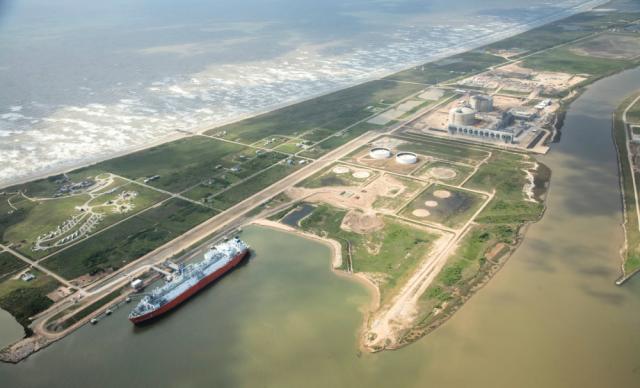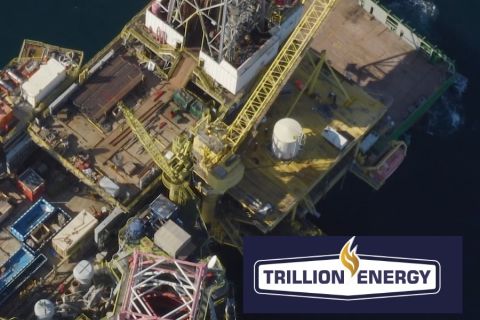
An ariel view of the Excelsior ship docked at the Freeport LNG terminal near Houston. The Freeport LNG facility normally exports about 2 Bcf/d and is responsible for roughly 15%-16% of total U.S. feedgas demand. (Source: Freeport LNG)
Learn more about Hart Energy Conferences
Get our latest conference schedules, updates and insights straight to your inbox.
Freeport LNG on June 14 reported estimates that its Texas plant, out of service following a fire last week, would remain fully offline until at least September.
The outage estimate is significantly longer than the three weeks that was initially reported, according to analysts at Enverus Intelligence Research.
“The extended outage is likely to help reduce the U.S. storage deficit to normal levels (currently ~300 Bcf below the 5-year average),” the Enverus analysts wrote June 14 in a research note to clients, adding that “assuming normal weather, ~175 Bcf more could be added to U.S. inventories.”
The outage of the Freeport LNG plant, which accounts for about 20% of U.S. LNG exports, will also exacerbate tightness in global LNG markets. The Enverus analysts expect this could leave some markets with less than anticipated gas in storage heading into winter while it will also lead to an increase in U.S. gas-fired generation.
“The Freeport facility normally exports ~ 2 Bcf/d and is responsible for roughly 15%-16% of total U.S. feedgas demand. Freeport (Train 1-3) has signed the deal of ~0.9 Bcf/d with Asian buyers (JERA, Osaka and SK E&S) and ~0.9 Bcf/d with global marketer (BP and Total),” the Enverus analysts wrote.
An incident on June 8 at Freeport’s Quintana Island, Texas liquefaction facility “resulted in the release of LNG, leading to the formation and ignition of a natural gas vapor cloud and subsequent fire,” the company announced June 14 in its press release. No injuries occurred during the incident and there are no known threats to surrounding communities, Freeport said.
The incident took place in pipe racks which support the transfer of LNG from the facility's LNG storage tank area to the terminal's dock facilities on the north side of Freeport LNG’s dock basin. “None of the liquefaction trains, LNG storage tanks, dock facilities or LNG process areas were impacted,” Freeport said.
Freeport LNG Development announced plans on June 14 for a partial restart and full return of operations at its three train, 15 million tonnes per annum Quintana facility after the recent fire. The plant could achieve partial operations in 90 days and a full return in late 2022 after completing all necessary repairs, according to the release.
Russia’s ongoing war in Ukraine coupled with global recession fear and depleting natural gas inventories continue to support higher commodity prices and energy demand.
U.S. LNG exporters have already boosted exports to Europe and other destinations amongst the uncertainties. Other LNG companies looking to take part in the gas boom are scrambling to ink export deals related to proposed LNG projects as some countries start to hedge bets on Russian gas.
“We’re monitoring the Freeport incident very closely. It’s a key component of LNG exports,” API president and CEO Mike Sommers said June 14 during a media conference discussing API’s policy plan to restore U.S. energy leadership.
API senior vice president of policy, economics and regulatory affairs Frank Macchiarola remained hopeful about filling Europe’s gas needs. “It's certainly important in a tight market that we face right now,” Macchiarola said during the media conference.
Houston-based Freeport LNG’s Quintana facility initiated LNG exports in 2019 and is now the seventh largest in the world and second largest in the U.S. Freeport has already received all regulatory approvals for construction of a fourth liquefaction train, according to details on its website.
The near-term export impact from the Quintana Island facility closure is expected to “be moderated in the first week by the use of LNG already in storage tanks to load ships, though a reduced liquefaction rate beyond that would start to be felt,” Goldman Sachs’ analysts Samantha Dart, Damien Courvalin and Romain Langlois wrote June 8 in a research note to clients.
“We estimate it would take an outage lasting more than 70 days before its estimated 20 MMcm/d impact on NW European storage took end-summer inventory levels below 90% of full versus our current 93% of full expectations. While uncertainty following the event may lend near-term support to both TTF [Title Transfer Facility] and JKM [Japan Korea Marker], it would take in our view an expected outage longer than two months to support a higher 3Q22 TTF price vs our 85 EUR/MWh forecast,” the analysts wrote referring to Europe’s and Asia’s TTF and JKM natural gas benchmarks.
Recommended Reading
Deepwater Roundup 2024: Offshore Europe, Middle East
2024-04-16 - Part three of Hart Energy’s 2024 Deepwater Roundup takes a look at Europe and the Middle East. Aphrodite, Cyprus’ first offshore project looks to come online in 2027 and Phase 2 of TPAO-operated Sakarya Field looks to come onstream the following year.
E&P Highlights: April 15, 2024
2024-04-15 - Here’s a roundup of the latest E&P headlines, including an ultra-deepwater discovery and new contract awards.
Trio Petroleum to Increase Monterey County Oil Production
2024-04-15 - Trio Petroleum’s HH-1 well in McCool Ranch and the HV-3A well in the Presidents Field collectively produce about 75 bbl/d.
Trillion Energy Begins SASB Revitalization Project
2024-04-15 - Trillion Energy reported 49 m of new gas pay will be perforated in four wells.
Exxon Ups Mammoth Offshore Guyana Production by Another 100,000 bbl/d
2024-04-15 - Exxon Mobil, which took a final investment decision on its Whiptail development on April 12, now estimates its six offshore Guyana projects will average gross production of 1.3 MMbbl/d by 2027.






